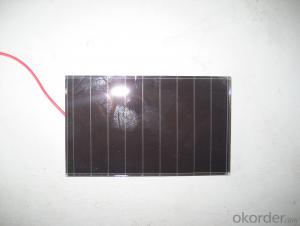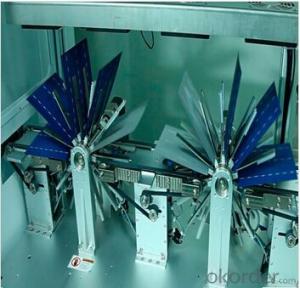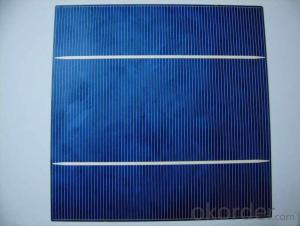Amorphous silicon dice specification 2
- Loading Port:
- China Main Port
- Payment Terms:
- TT OR LC
- Min Order Qty:
- -
- Supply Capability:
- -
OKorder Service Pledge
OKorder Financial Service
You Might Also Like
Pv modules at present, the mainstream products are still in silicon as the main raw materials, only in terms of silicon raw material consumption, production 1 mw of crystalline silicon solar cell, need 10 to 12 tons of high purity silicon, but if use the same silicon materials used to produce thin film amorphous silicon solar cell can produce more than 200 mw.
From the perspective of energy consumption, amorphous silicon solar battery only 1-1.5 years of energy recovery period, more embodies its contribution to energy saving in the manufacturing process.
Component occupies a high proportion of costs in a photovoltaic system, the component prices directly affect the system cost, and thus affect the cost of photovoltaic power generation. Calculated at the current price of components, the same money, buy amorphous silicon products, you can get more close to 30% of the power components.
2, more power
For the same power of solar cell array, amorphous silicon solar cell is about 10% more than monocrystalline silicon, polycrystalline silicon battery power. This has been the Uni - Solar System LLC, Energy Photovoltaic Corp., Japan's Kaneka Corp., the Netherlands Energy research institute, and other organizations and experts confirmed that the Photovoltaic industry.
In sunny, that is to say, under the high temperature, amorphous silicon solar cell components can show more excellent power performance.
3, better low light response
Due to the characteristics of amorphous silicon atoms are arranged disorderly, the electron transition no longer comply with the restriction of traditional \"selection rule\", as a result, its light absorption characteristics and there are big differences monocrystalline silicon material. Amorphous silicon and monocrystalline silicon material absorption curve as shown
, amorphous silicon absorption curve has obvious three sections (A, B, C). Area A corresponding electronic transition between localized states, such as the gap state near Fermi level and to the tail state transition, the absorption coefficient is small, about 1-10 cm - 1, for this is absorbing; B area absorption coefficient with the increase of the photon energy index rose, it corresponds to the electrons from the valence band edge extension state to the conduction band localized state transition, as well as the localized electrons from the valence band tail states guide for edge extension state transition, the region's energy range is usually only about half of the electron volts, but absorption coefficient across two or three orders of magnitude, usually up to 104 cm - 1; Area C corresponds to the electrons from the valence band to the conduction band internal internal transition, the absorption coefficient is bigger, often in more than 104 cm - 1. After two absorption area is crystalline silicon eigen absorption area.
Can be seen in the figure, the intersection of two curves about 1.8 ev. It is important to note that in the visible light range (1.7 to 3.0 ev), the absorption coefficient of amorphous silicon material is almost an order of magnitude larger than the single crystal silicon. That is to say, in the morning the first part of the sun is not too strong, the second half, and it's cloudy in the afternoon under the condition of low light intensity, long wave is greater, the amorphous silicon material still has a large absorption coefficient. Again considering the amorphous silicon band gap is larger, the reverse saturation current I0 is smaller. And as mentioned the amorphous silicon battery the characteristics I - V characteristic curve of the amorphous silicon solar cell both in theory and in practical use in low light intensity has good adaptation.
• I - V characteristics of amorphous silicon cells after more than a Vm with the voltage drop slowly
In order to be convenient, we draw the I - V characteristics of two kinds of batteries on the same picture. Crystalline silicon and amorphous silicon battery I - V characteristics of general shape as shown
we see from the picture, two kinds of cells in the curve changes after exceed the maximum output power point gap is bigger. Output current of crystalline silicon cells after exceed the maximum output power point will soon fall to zero, curve steep; Rather than crystalline silicon cells output current after a long distance to fall to zero, the curve is relatively flat. Two kinds of battery Vm equivalent to about 83% of its open circuit voltage and 83% respectively.
when light intensity gradually become hour, short circuit current and open circuit voltage of solar battery will be stronger. Short circuit current decreases faster, of course, open circuit voltage decrease more slowly.
do in battery solar cell array under the condition of load, when the sun battery array of effective output voltage less than the terminal voltage of battery, battery cannot be recharged. When the light intensity gradually become hour, crystal silicon battery charging does not meet the conditions, and amorphous silicon due to the larger voltage difference, do not charge until the light is very dark, effectively increase the use of sunlight time. So, amorphous silicon cells to produce more electricity than the crystalline silicon.
4, more excellent high temperature performance
High in the outdoor environment temperature, amorphous silicon solar cell performance change, depends on the temperature, spectrum, as well as other related factors. But what is certain is: amorphous silicon than monocrystalline silicon or polycrystalline silicon are less likely to be affected by temperature.
Amorphous silicon solar cells than monocrystalline silicon, polycrystalline silicon cells have relatively small temperature coefficient of amorphous silicon solar cell output power best Pm temperature coefficient is about 0.19%, and monocrystalline silicon, polycrystalline silicon cells best output power Pm temperature coefficient is about 0.5%, when the battery work at higher temperatures, the two batteries will be a drop in the Pm, but the decline is different. They can be calculated using the following formula.
- Q:How is a microinverter integrated into a solar silicon wafer?
- A microinverter is not directly integrated into a solar silicon wafer. Instead, it is typically connected to the solar panels after the silicon wafer has been manufactured and made into a solar cell. The microinverter is then installed on the back of each individual solar panel, allowing for the conversion of the DC (direct current) power generated by the solar panel into AC (alternating current) power that can be used by the electrical grid or household appliances.
- Q:Can solar silicon wafers be used in floating solar power plants?
- Yes, solar silicon wafers can be used in floating solar power plants. These solar wafers, which are made from crystalline silicon, can be integrated into floating photovoltaic (PV) systems to generate electricity from solar energy. Floating solar power plants are becoming increasingly popular due to their ability to maximize land usage and reduce water evaporation.
- Q:How are solar silicon wafers tested for mechanical strength and durability?
- Solar silicon wafers are tested for mechanical strength and durability through a series of rigorous tests. These tests typically involve subjecting the wafers to various mechanical stresses and environmental conditions to simulate real-world conditions. Some common tests include bend and flex tests, where the wafers are subjected to controlled bending forces, and impact tests, where they are exposed to physical impacts. Additionally, thermal cycling tests are performed to assess the wafers' ability to withstand extreme temperature changes. These tests help determine the structural integrity and durability of solar silicon wafers, ensuring their reliability and performance in solar cell applications.
- Q:How does the size of a solar silicon wafer affect the efficiency of a solar panel?
- The size of a solar silicon wafer does not directly affect the efficiency of a solar panel. The efficiency is primarily determined by the quality of the silicon material and the manufacturing processes used. However, larger wafers can lead to larger solar cells, which can increase the overall power output of a panel.
- Q:What is the purpose of a power output in a solar silicon wafer?
- The purpose of a power output in a solar silicon wafer is to convert sunlight into usable electrical energy.
- Q:What is the role of grid lines on solar silicon wafers?
- The role of grid lines on solar silicon wafers is to facilitate the flow of electric current from the sun-exposed surface of the wafer to the electrical contacts. These grid lines act as pathways to collect and transport the generated electricity, improving the overall efficiency and performance of the solar cells.
- Q:Silicon wafer is not light mixed with heavy doping?That is not mixed with P type N type, then ask what is the meaning of SUBThere are light doped tablets with heavy doping in the semiconductor industry is how to express?
- Otherwise, the light is mixed, N++/P++ said heavy doping, no plus is light, thank you
- Q:How does the efficiency of a solar silicon wafer vary with different light conditions?
- The efficiency of a solar silicon wafer varies with different light conditions. In optimal sunlight conditions, the efficiency is generally higher as the wafer can absorb a greater amount of sunlight and convert it into electricity more effectively. However, in low light conditions such as cloudy or overcast weather, the efficiency decreases as the wafer receives less sunlight to convert into electricity. Similarly, the efficiency may also be affected by the angle of incidence and shading caused by surrounding objects, which can decrease the overall efficiency of the wafer.
- Q:What's the difference between a silicon wafer and a battery?
- Silver aluminum printing products called battery!The silicon chip is the raw material for the production of the battery chip, and the silicon chip is conductive!
- Q:How are solar silicon wafers coated to prevent reflection losses?
- Solar silicon wafers are coated with an anti-reflective (AR) coating to minimize reflection losses. This coating is typically a thin film of materials such as silicon nitride or titanium dioxide, which have a low refractive index. The AR coating helps to reduce the amount of sunlight that is reflected away from the surface of the wafer, allowing more light to be absorbed and converted into electricity.
1. Manufacturer Overview |
|
|---|---|
| Location | |
| Year Established | |
| Annual Output Value | |
| Main Markets | |
| Company Certifications | |
2. Manufacturer Certificates |
|
|---|---|
| a) Certification Name | |
| Range | |
| Reference | |
| Validity Period | |
3. Manufacturer Capability |
|
|---|---|
| a)Trade Capacity | |
| Nearest Port | |
| Export Percentage | |
| No.of Employees in Trade Department | |
| Language Spoken: | |
| b)Factory Information | |
| Factory Size: | |
| No. of Production Lines | |
| Contract Manufacturing | |
| Product Price Range | |
Send your message to us
Amorphous silicon dice specification 2
- Loading Port:
- China Main Port
- Payment Terms:
- TT OR LC
- Min Order Qty:
- -
- Supply Capability:
- -
OKorder Service Pledge
OKorder Financial Service
Similar products
New products
Hot products
Hot Searches
Related keywords
























